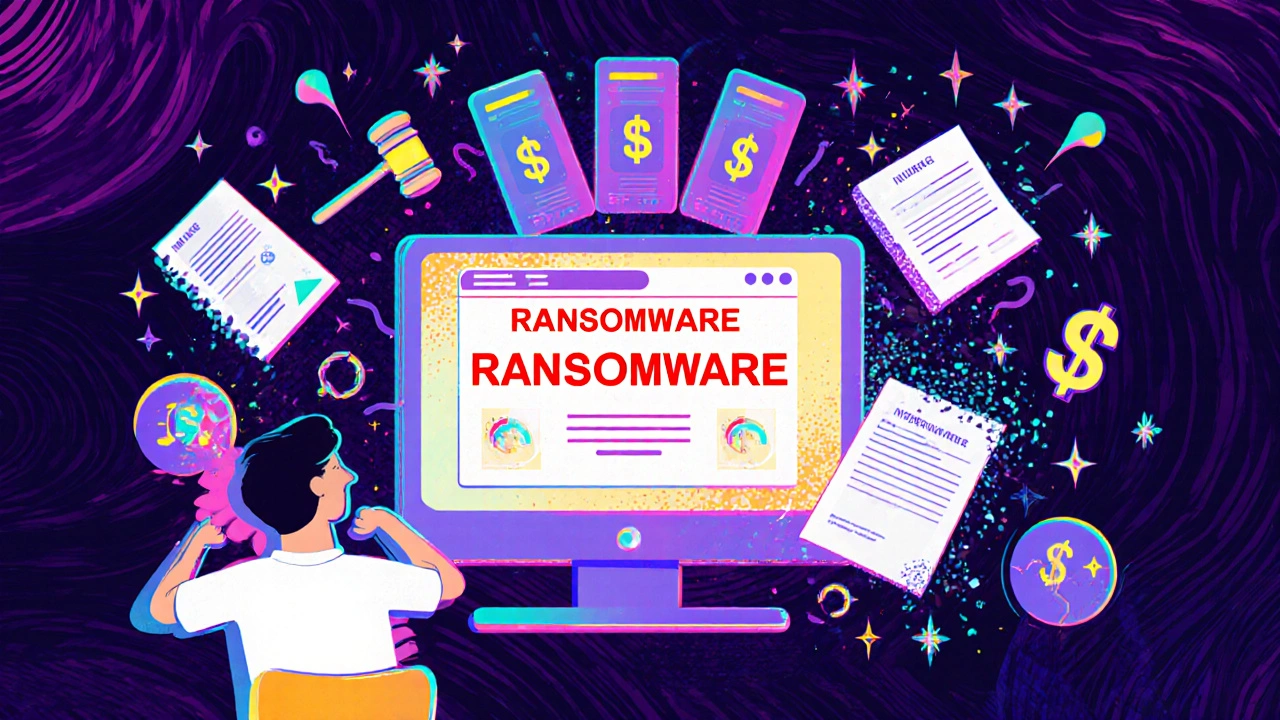Cyber Insurance Cost Calculator
Estimate Your Premium
Estimated Coverage
Annual Premium Estimate:
Based on industry standards and business factors
What's Included
- First-party coverage for forensic investigations and business interruption
- Third-party coverage for lawsuits and regulatory fines
- Notification costs for customer data breaches
- Costs for data restoration and recovery
Important Notes
Security requirements matter: Premiums decrease with strong security controls like multi-factor authentication and endpoint detection tools.
Documentation is critical: Claims can be denied without proper logs, backups, and incident response plans.
When a hacker locks up your company’s files and demands $500,000 to unlock them, or when a data breach exposes customer records and triggers legal fines, the real cost isn’t just the ransom or the fine. It’s the lost sales, the reputational damage, the legal fees, the notification letters to affected customers, and the hours your team spends fixing what was broken. That’s where cybersecurity insurance comes in - not as a magic shield, but as a financial safety net when your defenses fail.
What Cybersecurity Insurance Actually Covers
Cybersecurity insurance doesn’t stop attacks. It pays for the mess after they happen. Policies are split into two main parts: first-party coverage and third-party coverage.First-party coverage handles your direct losses. This includes the cost of hiring forensic investigators to find out how the breach happened - typically $15,000 to $100,000 or more. It covers business interruption, which can cost $500 to $5,000 per hour depending on your size. If your systems go down during a ransomware attack, this part pays for lost revenue. It also pays for restoring or replacing damaged data, which averages $20,000 to $100,000 per incident. And if you have to notify customers - say, 10,000 people - the cost of mailing letters, setting up call centers, and offering credit monitoring can add up to $5,000 to $20,000.
Third-party coverage protects you from lawsuits. If a customer sues you because their data was stolen, or if a vendor claims your system caused their outage, this part kicks in. It pays for legal defense, settlements, and regulatory fines. In the U.S., fines under HIPAA or state privacy laws can hit millions. GDPR in Europe can fine you up to 4% of your global revenue. Most policies cover privacy liability, network security liability, and media liability (like copyright infringement from content you posted online).
How Much Does It Cost?
There’s no flat rate. Premiums depend on your size, industry, security posture, and how much coverage you need. Small businesses often pay between $10,000 and $25,000 a year. Larger companies with complex systems can pay over $100,000 annually. Coverage limits usually range from $1 million to $100 million. Deductibles - the amount you pay before the insurance kicks in - typically start at $10,000 and can go as high as $250,000 for big enterprises.Here’s the catch: insurers aren’t just selling policies. They’re demanding proof you’ve taken steps to prevent attacks. Nearly 92% of insurers require multi-factor authentication. Most demand endpoint detection and response (EDR) tools, regular vulnerability scans, and documented incident response plans. If you don’t meet these requirements, you won’t get coverage - or your claim could be denied later.
Why Small Businesses Are Getting Left Behind
While 85-90% of large enterprises have cyber insurance, only 10-20% of small and mid-sized businesses do. Why? Affordability is one reason. But more often, it’s complexity. Many small business owners don’t understand what’s required. They fill out a 150-question security questionnaire, check boxes they think are right, and assume they’re covered. Then, when a ransomware attack hits, the insurer denies the claim because backups weren’t air-gapped, or employee training logs were incomplete.A Trustpilot review from February 2025 tells the story: after a ransomware attack, a small business waited 127 days for a claim payout - and got denied for 30% of their costs because their backups didn’t meet policy requirements. That’s not unusual. A SANS Institute study found 68% of claim denials happened because businesses misunderstood their policy exclusions.
How the Market Is Changing
The cyber insurance market hit $16.6 billion in 2025, up from $15.3 billion in 2024. But growth isn’t linear. For the first time in seven years, global cyber insurance rates dropped by 6% in Q3 2024. Why? Too much supply, not enough demand. Insurers flooded the market with policies, but many businesses still don’t buy them - especially smaller ones.Insurers are adapting. Instead of just writing checks, they’re partnering with cybersecurity firms like CrowdStrike and Palo Alto Networks to bundle insurance with security tools. This way, they reduce risk upfront. If you buy a policy from Coalition, you get not just coverage, but real-time threat monitoring, phishing training, and automated patching.
Claims are also changing. Ransomware is still the top cause of losses, but insurers now see more payouts for contingent business interruption - like when your cloud provider goes down, and your whole operation stops. Privacy lawsuits are rising too. In 2024, wrongful data collection and processing accounted for 28% of large claims.
Who Needs It Most?
Some industries are already covered at near-universal rates. Financial services: 92%. Healthcare: 88%. Tech companies: 85%. These sectors handle sensitive data and face strict regulations. But manufacturing? Only 65%. Retail? Just 58%. These businesses think they’re not targets - but hackers don’t care. They go for the weakest link. A retail store with outdated POS systems is just as vulnerable as a bank.If you handle customer data, process payments, use cloud services, or rely on digital systems to operate - you need cyber insurance. It’s not optional anymore. The cost of not having it can wipe out a small business.

How to Get It Right
Getting cyber insurance isn’t like buying car insurance. You can’t just pick a plan online. Here’s what actually works:- Assess your risk. What systems are most critical? What data do you store? What would happen if it disappeared?
- Fix your security first. Implement multi-factor authentication. Use EDR tools. Back up data daily - and test those backups. Train employees on phishing.
- Get a broker who specializes in cyber insurance. General insurance agents don’t understand the nuances. Look for someone who’s worked with at least 20 cyber claims.
- Read the policy like a lawyer. Pay attention to exclusions: Do they exclude attacks from known vulnerabilities? Do they require patching within 30 days? Are AI-generated attacks covered?
- Document everything. Network diagrams, training logs, patch schedules, incident response plans. If you don’t have it in writing, the insurer won’t believe you had it.
It takes 2 to 4 weeks to get approved. Don’t rush it. If you skip steps, you’re setting yourself up for a denied claim.
What’s Next for Cyber Insurance?
The market is moving toward standardization. Insurers are finally agreeing on what “reasonable security” means. More policies will include proactive services - not just payouts. Expect to see AI-driven risk scoring, where your premium adjusts in real time based on your network’s threat level.But the biggest opportunity? The SME market. Right now, 80% of small businesses are uninsured. That’s a $10 billion gap. Insurers who figure out how to make policies simple, affordable, and easy to understand will dominate the next decade.
Cybersecurity insurance isn’t about feeling safe. It’s about knowing you won’t go under when the worst happens. The threat landscape isn’t getting quieter. It’s getting smarter. Your insurance should be too.
Does cybersecurity insurance cover ransomware payments?
Some policies do, but many now exclude direct ransom payments - especially if they violate U.S. Treasury sanctions. Instead, coverage typically pays for incident response, data recovery, and business interruption caused by the attack. Paying the ransom doesn’t guarantee your data is restored, and it may violate the law. Insurers now focus on helping you recover without paying.
Can I get cyber insurance if my security isn’t perfect?
Yes - but you’ll pay more, and your coverage may have exclusions. Insurers often require minimum controls like multi-factor authentication and endpoint protection. If you’re missing key safeguards, they might deny coverage for certain types of attacks, like those exploiting unpatched software. The goal isn’t perfection - it’s meeting industry standards. Work with a broker to understand what’s achievable.
How long does a cyber insurance claim take to process?
It varies. Simple claims - like notification costs - can be paid in 30 to 60 days. Complex ones involving business interruption or legal liability can take 90 to 180 days. The key is documentation. If you’ve kept detailed logs, backups, and incident reports, the process moves faster. Many businesses report delays because they didn’t maintain the records insurers require.
Are AI-powered attacks covered by cyber insurance?
Most policies don’t explicitly mention AI - but they also don’t exclude it. Coverage depends on the result, not the method. If an AI-generated phishing email leads to a data breach, your privacy liability coverage would apply. However, some newer policies are adding exclusions for attacks using untested AI tools. Always ask your broker whether your policy covers emerging threat types.
Do I need cyber insurance if I have a good IT team?
Yes. Even the best teams can’t prevent every attack. Human error, zero-day exploits, and supply chain compromises happen. Cyber insurance doesn’t replace security - it complements it. When an incident occurs, the insurance provides access to forensic experts, legal counsel, and PR teams you can’t afford to hire on your own. It’s the difference between managing a crisis alone and having a team of professionals respond within hours.
Can I cancel my cyber insurance if my risk decreases?
You can cancel, but it’s risky. Cyber threats evolve quickly. A system that’s secure today might be vulnerable tomorrow due to new software updates or third-party breaches. Many insurers offer multi-year policies with rate guarantees. Canceling leaves you exposed, and reapplying later could mean higher premiums or stricter requirements. Think of it like fire insurance - you don’t cancel it because you haven’t had a fire.






Comments
Let’s be real - cyber insurance is the modern-day equivalent of buying a fire extinguisher for your house while still lighting candles in the attic. I’ve seen too many SMEs shell out $20k/year for coverage that gets denied because they didn’t air-gap their backups like some medieval monk guarding the Holy Grail. The real scandal? Insurers are turning into security consultants with payout clauses. If you’re not doing EDR, MFA, and daily patch audits, you’re not insured - you’re just a liability waiting for a denial letter.
Thanks for this breakdown 🙏. I run a small dev shop in India and was terrified to even look into cyber insurance - thought it was only for big corps. Now I see it’s less about being perfect and more about being *documented*. Our team just started using MFA and weekly scans. Maybe we’re not ready yet… but at least we’re trying. Hope the market gets simpler for guys like us soon.
One thing that’s rarely mentioned: cyber insurance doesn’t cover the emotional toll. I watched a client lose their 12-year-old business after a ransomware attack - not because they couldn’t pay the ransom, but because the insurer took 147 days to respond, and their customers vanished during the silence. The policy paid for the forensic report, but not the sleepless nights, the divorce papers, or the shame of telling your staff they’re out of a job. Insurance fixes the ledger. It doesn’t fix the human wreckage.
Y’all are missing the real trend: cyber insurance is becoming a SaaS product. Coalition, Zensurance, Cytelligence - they’re not selling policies, they’re selling security-as-a-service with a deductible. You get phishing sims, automated patching, threat intel dashboards, and AI risk scoring baked in. It’s like having a CISO on retainer. If you’re still using a general agent who thinks ‘cyber’ is a type of taco… you’re already behind. This isn’t insurance anymore. It’s survival tech.
Wow. So we’re now paying $100k/year for a policy that won’t cover ransomware payments because paying ransoms is ‘immoral’? And we’re supposed to trust that the insurer’s ‘incident response team’ will magically restore our data faster than the hackers? This isn’t insurance - it’s a psychological warfare tactic disguised as a contract. The real threat isn’t the hackers. It’s the lawyers who wrote the exclusions.